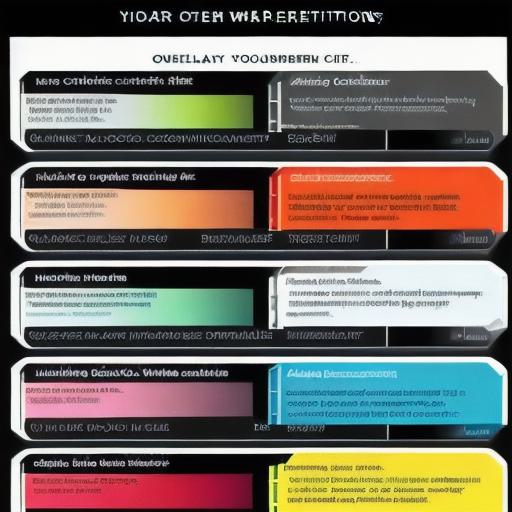Introduction
Marketing orientation is an essential aspect of any successful business strategy. It refers to the way a company positions itself, communicates with customers, and creates value for them. This article aims to explore the definition of marketing orientation, its benefits, and how it can impact businesses in today’s competitive market. By understanding the importance of a well-defined marketing orientation, companies can make informed decisions that will help them succeed in their respective industries.
Defining Marketing Orientation

Marketing orientation refers to a company’s approach towards marketing activities. It includes the company’s attitude, values, and beliefs regarding marketing, as well as its strategy and tactics for creating value for customers. The primary goal of marketing orientation is to ensure that a company provides excellent customer experiences that drive business growth and profitability.
The Benefits of Marketing Orientation
Marketing orientation has numerous benefits that can help businesses succeed in the marketplace. Some of these benefits include:
- Improved Customer Satisfaction
Companies with a strong marketing orientation focus on understanding their customers’ needs, wants, and desires. They tailor their products, services, and communications to meet these needs, resulting in increased customer satisfaction levels. - Competitive Advantage
Marketing orientation helps companies stay ahead of the competition by identifying trends, innovations, and new opportunities for growth. This allows them to respond quickly to changing market conditions and capture a larger share of the market. - Increased Brand Awareness
Companies with a strong marketing orientation invest heavily in building their brand reputation, which helps them increase brand awareness and recognition. - Enhanced Sales Performance
Marketing orientation helps companies improve their sales performance by creating a customer-centric culture that drives sales growth. This involves developing effective marketing campaigns, providing excellent customer service, and leveraging data analytics to gain insights into customer behavior. - Improved Employee Engagement
Companies with a strong marketing orientation foster a culture of innovation, creativity, and collaboration among employees. This leads to increased employee engagement levels and higher job satisfaction rates.
The Impact of Marketing Orientation on Businesses
Marketing orientation has a significant impact on businesses in today’s marketplace. Here are some of the ways it can impact businesses:
- Product Development
Companies with a strong marketing orientation invest heavily in research and development to create innovative products that meet customer needs and preferences. This helps them stay ahead of the competition and capture a larger share of the market. - Pricing Strategies
Marketing orientation influences pricing strategies by considering factors such as market demand, competition, and customer value perception. Companies use these insights to set prices that are competitive yet profitable. - Distribution Channels
Marketing orientation impacts distribution channels by identifying the most effective ways to reach customers. This includes online sales, brick-and-mortar stores, or a combination of both. - Customer Service
Companies with a strong marketing orientation prioritize customer service as an essential component of their business strategy. They invest in providing excellent customer experiences, including fast and reliable delivery, personalized communication, and prompt resolution of issues. - Marketing Communications
Marketing orientation influences marketing communications by creating messaging that resonates with customers and reflects the company’s brand values. This helps to build trust and credibility among customers, leading to increased brand loyalty and repeat business.
Real-Life Examples of the Impact of Marketing Orientation
Let’s look at some real-life examples of how marketing orientation has impacted businesses:
- Apple Inc.
Apple is a prime example of a company with a strong marketing orientation. The company focuses on creating innovative products that meet customer needs and preferences, such as the iPhone, iPad, and MacBook. Apple’s pricing strategies are based on premium quality and exclusivity, which has helped the company capture a significant market share. Apple’s distribution channels include online sales, brick-and-mortar stores, and selective partnerships with retailers. Apple provides excellent customer service through its Genius Bar, which offers fast and reliable support to customers. Apple’s marketing communications focus on creating an emotional connection with customers through storytelling, advertising, and product design.
- Amazon.com
Amazon is another company that has successfully implemented a strong marketing orientation. The company’s primary focus is on providing the best possible customer experience by offering a vast selection of products at competitive prices, fast and reliable delivery, and excellent customer service. Amazon’s pricing strategies are based on the principle of "everything under the sun" and have helped the company capture a significant market share in e-commerce. Amazon’s distribution channels include online sales, brick-and-mortar stores, and selective partnerships with retailers. Amazon provides excellent customer service through its 24/7 customer support and fast delivery options. Amazon’s marketing communications focus on creating a sense of urgency and convenience by offering promotions, discounts, and recommendations to customers. - McDonald’s Corporation
McDonald’s is an excellent example of a company that has struggled with a weak marketing orientation. The company’s primary focus has been on providing fast and inexpensive food options, which has resulted in a decline in sales and market share. McDonald’s pricing strategies have been based on low prices to attract price-sensitive customers, but this has also led to lower profit margins. McDonald’s distribution channels are primarily brick-and-mortar stores, which have become outdated in today’s digital age. McDonald’s customer service has been criticized for being slow and impersonal, leading to negative customer experiences. McDonald’s marketing communications focus on promoting its signature items, such as hamburgers and fries, but these offerings are no longer relevant to modern consumers who prefer healthier and more customizable options.
Case Studies of the Impact of Marketing Orientation
Let’s look at some case studies that illustrate the impact of marketing orientation on businesses:
- Coca-Cola Company
Coca-Cola is a prime example of a company that has successfully implemented a strong marketing orientation. The company focuses on creating emotional connections with customers through its iconic branding and messaging, such as "Share a Coke" and "Open Happiness." Coca-Cola’s pricing strategies are based on premium quality and exclusivity, which has helped the company capture a significant market share in beverages. Coca-Cola’s distribution channels include online sales, vending machines, and selective partnerships with retailers. Coca-Cola provides excellent customer service through its brand ambassadors, who engage with customers and promote the brand on social media. Coca-Cola’s marketing communications focus on creating a sense of community and togetherness by promoting social events and initiatives. - Netflix Inc.
Netflix is an excellent example of a company that has successfully implemented a strong marketing orientation. The company focuses on providing the best possible customer experience by offering a vast selection of movies, TV shows, and original content at competitive prices, fast and reliable delivery, and excellent customer service. Netflix’s pricing strategies are based on subscription-based models that offer flexibility and value to customers. Netflix’s distribution channels include online sales and selective partnerships with cable providers. Netflix provides excellent customer service through its recommendation algorithms, which suggest personalized content to each user. Netflix’s marketing communications focus on creating a sense of exclusivity and anticipation by promoting new releases and award-winning original content. - Zappos Inc.
Zappos is an excellent example of a company that has successfully implemented a strong marketing orientation. The company focuses on providing the best possible customer experience by offering free and fast shipping, exceptional customer service, and personalized communication. Zappos’ pricing strategies are based on competitive prices and frequent promotions to attract price-sensitive customers. Zappos’ distribution channels include online sales and selective partnerships with retailers. Zappos provides excellent customer service through its "Zapier" system, which automates many customer service tasks and allows employees to focus on building relationships with customers. Zappos’ marketing communications focus on creating a sense of community and connection by promoting social events and initiatives that align with the company’s values.
Conclusion
In conclusion, marketing orientation is a critical component of any business strategy. A strong marketing orientation focuses on meeting customer needs and preferences, providing excellent customer service, and creating emotional connections with customers. By implementing a strong marketing orientation, businesses can capture market share, build brand loyalty, and achieve long-term success. On the other hand, a weak marketing orientation can result in declining sales, negative customer experiences, and a loss of market share. Therefore, it is essential for businesses to prioritize a strong marketing orientation as part of their overall business strategy.




